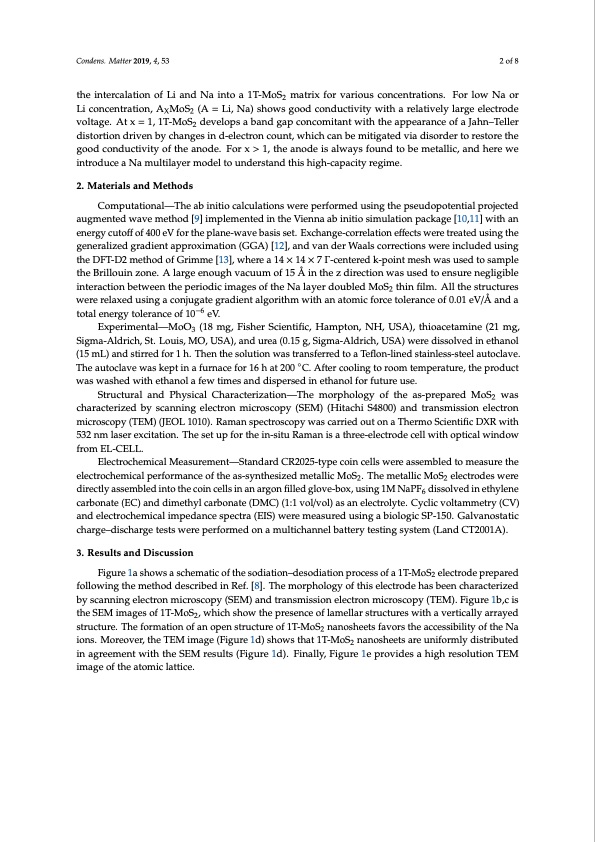
PDF Publication Title:
Text from PDF Page: 002
Condens. Matter 2019, 4, 53 2 of 8 the intercalation of Li and Na into a 1T-MoS2 matrix for various concentrations. For low Na or Li concentration, AXMoS2 (A = Li, Na) shows good conductivity with a relatively large electrode voltage. At x = 1, 1T-MoS2 develops a band gap concomitant with the appearance of a Jahn–Teller distortion driven by changes in d-electron count, which can be mitigated via disorder to restore the good conductivity of the anode. For x > 1, the anode is always found to be metallic, and here we introduce a Na multilayer model to understand this high-capacity regime. 2. Materials and Methods Computational—The ab initio calculations were performed using the pseudopotential projected augmented wave method [9] implemented in the Vienna ab initio simulation package [10,11] with an energy cutoff of 400 eV for the plane-wave basis set. Exchange-correlation effects were treated using the generalized gradient approximation (GGA) [12], and van der Waals corrections were included using the DFT-D2 method of Grimme [13], where a 14 × 14 × 7 Γ-centered k-point mesh was used to sample the Brillouin zone. A large enough vacuum of 15 Å in the z direction was used to ensure negligible interaction between the periodic images of the Na layer doubled MoS2 thin film. All the structures were relaxed using a conjugate gradient algorithm with an atomic force tolerance of 0.01 eV/Å and a total energy tolerance of 10−6 eV. Experimental—MoO3 (18 mg, Fisher Scientific, Hampton, NH, USA), thioacetamine (21 mg, Sigma-Aldrich, St. Louis, MO, USA), and urea (0.15 g, Sigma-Aldrich, USA) were dissolved in ethanol (15 mL) and stirred for 1 h. Then the solution was transferred to a Teflon-lined stainless-steel autoclave. The autoclave was kept in a furnace for 16 h at 200 ◦C. After cooling to room temperature, the product was washed with ethanol a few times and dispersed in ethanol for future use. Structural and Physical Characterization—The morphology of the as-prepared MoS2 was characterized by scanning electron microscopy (SEM) (Hitachi S4800) and transmission electron microscopy (TEM) (JEOL 1010). Raman spectroscopy was carried out on a Thermo Scientific DXR with 532 nm laser excitation. The set up for the in-situ Raman is a three-electrode cell with optical window from EL-CELL. Electrochemical Measurement—Standard CR2025-type coin cells were assembled to measure the electrochemical performance of the as-synthesized metallic MoS2. The metallic MoS2 electrodes were directly assembled into the coin cells in an argon filled glove-box, using 1M NaPF6 dissolved in ethylene carbonate (EC) and dimethyl carbonate (DMC) (1:1 vol/vol) as an electrolyte. Cyclic voltammetry (CV) and electrochemical impedance spectra (EIS) were measured using a biologic SP-150. Galvanostatic charge–discharge tests were performed on a multichannel battery testing system (Land CT2001A). 3. Results and Discussion Figure 1a shows a schematic of the sodiation–desodiation process of a 1T-MoS2 electrode prepared following the method described in Ref. [8]. The morphology of this electrode has been characterized by scanning electron microscopy (SEM) and transmission electron microscopy (TEM). Figure 1b,c is the SEM images of 1T-MoS2, which show the presence of lamellar structures with a vertically arrayed structure. The formation of an open structure of 1T-MoS2 nanosheets favors the accessibility of the Na ions. Moreover, the TEM image (Figure 1d) shows that 1T-MoS2 nanosheets are uniformly distributed in agreement with the SEM results (Figure 1d). Finally, Figure 1e provides a high resolution TEM image of the atomic lattice.PDF Image | Understanding Phase Stability of Metallic 1T-MoS2 Anodes for Sodium-Ion Batteries

PDF Search Title:
Understanding Phase Stability of Metallic 1T-MoS2 Anodes for Sodium-Ion BatteriesOriginal File Name Searched:
condensedmatter-04-00053.pdfDIY PDF Search: Google It | Yahoo | Bing
Sulfur Deposition on Carbon Nanofibers using Supercritical CO2 Sulfur Deposition on Carbon Nanofibers using Supercritical CO2. Gamma sulfur also known as mother of pearl sulfur and nacreous sulfur... More Info
CO2 Organic Rankine Cycle Experimenter Platform The supercritical CO2 phase change system is both a heat pump and organic rankine cycle which can be used for those purposes and as a supercritical extractor for advanced subcritical and supercritical extraction technology. Uses include producing nanoparticles, precious metal CO2 extraction, lithium battery recycling, and other applications... More Info
| CONTACT TEL: 608-238-6001 Email: greg@infinityturbine.com | RSS | AMP |